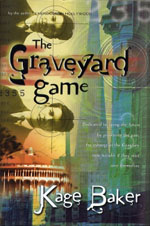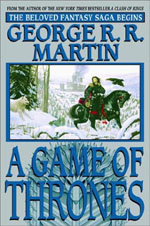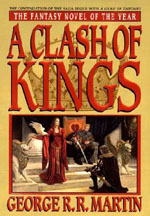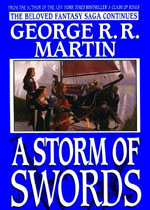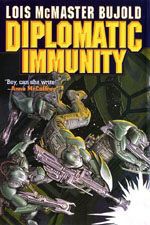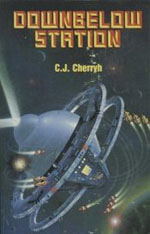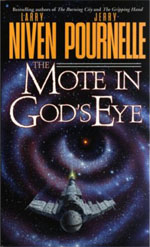 I had fairly high expectations for The Mote in God’s Eye. For years I’ve seen it listed time and time again alongside all-time greats like the Foundation Trilogy and Childhood’s End. It’s frequently described as the greatest first contact novel of all time, and I’ve even seen many describe it as the greatest SF novel of all time.
I had fairly high expectations for The Mote in God’s Eye. For years I’ve seen it listed time and time again alongside all-time greats like the Foundation Trilogy and Childhood’s End. It’s frequently described as the greatest first contact novel of all time, and I’ve even seen many describe it as the greatest SF novel of all time.
In the reading of it, I’m fairly underwhelmed. But we’ll get to that.
THE SCENARIO
A thousand years in the future, humanity has spread to the stars. Scientific revolution has discovered points of inconsistency in the space-time continuum, and technological innovation has created the Alderson drive which allows mankind to travel instantaneously through these points, resulting in a network linking the many stars and worlds of human space. Accidental inspiration has also led to the creation of the Langston Field – a generated shield capable of absorbing tremendous amounts of energy in form (kinetic, chemical, etc.).
Interstellar politics of the day have lent themselves to an aristocratic empire, whose will is enforced through military might in the form of warships protected by Langston Fields and capable of wiping out entire planetary populations. The borders of this empire are in constant flux, with numerous military campaigns being waged in an attempt to unite all of mankind.
Into this tenuous situation, a ship driven by solar sail enters the New Caledonia system. Within it are the first aliens ever seen by humanity. Now an expedition must be sent to the system from which the ship came, but even before it leaves, Niven and Pournelle clearly define their scenario of mystery and intrigue: On the one side, there are the utter unknowns of the aliens and their culture. On the other, the Empire must do everything in its power to guard the secrets of the Alderson drive and the Langston Field – for these may be the only advantages they have.
FIRST IMPRESSIONS
In the first hundred pages or so, The Mote in God’s Eye reminded me strongly of Rendezvous with Rama. Not so much in the particulars, which were quite different, but rather in the general feel: There is, of course, the appearance of the alien vessel and the mystery it represents. The science is also very hard (with the notable handwave-tech exceptions of drive and field), particularly when it comes to describing spaceship maneuvers. The politics of academia are detailed, well-drawn, and have an immediate (and understandable) impact on how the aliens are approached.
This early part of the novel also distinguishes itself as a page-turner. The timeline which leads off the book, after summarizing a thousand years of future history, closes enigmatically with, “3019: FIRST CONTACT.” The Prologue which immediately follows it further draws you into the novel, emphasizing the essential mystery of the vastness of space. And then, of course, there is the alien ship itself.
The writing here is tight. The plotting is intense. The mystery is fascinating. The stakes are high.
And then problems start developing.
A BOOK OF TWO PARTS
In many ways, I’m struck by the fact that The Mote in God’s Eye is really a book of two parts.
For example, the first problem to really strike me about Mote were the characters. Or rather, the caricatures, which were what stood in for actual personality among most of the book’s characters. On top of the fact that most of the characters are woodenly drawn, many of them are also forced into situations which doesn’t make a lot of sense: A suspected traitor, for example, is not only allowed to accompany the expedition to the alien homeworld, but is allowed unmonitored access to the aliens. Considering that the expedition is explicitly charged with the protection of Imperial secrets, this is absolutely bizarre.
But, on the other hand, there are some characters which seem capable of leaping off the page. And despite the fact that so much of the character development feels as if the authors are simply pushing them around a game board (the love story, example), some of it is painfully powerful and believable (such as the experiences of the aforementioned traitor).
Another example of this inconsistency are the aliens themselves. They are frequently described as one of the best alien species in the history of science fiction. And they are… for the first half of the book. But as more details reveal themselves, inconsistencies and logical holes begin to develop. Not enough to rob them of their effectiveness and cleverness, but enough to mar what would otherwise have been a flawless creation.
The careful thought labored upon the aliens is even more sharply contrasted against the human society depicted. On the one hand, Niven and Pournelle specifically call attention to the vast gulf of time which separates us from the Second Empire. (Sometimes in silly ways. For example, by asserting that George Washington and Alexander the Great are though of as practically contemporary by most people in the future.) But, on the other hand, the Second Empire they show us is really nothing more than an analog of the 20th century with a 19th century aristocracy thrown in for flavor: Here’s New Scotland, populated by entirely by the Scottish – who, after a thousand years, still speak with a Scottish accent, wear Scottish clothing, and are famed for their engineering skills. Over here Arabs and Jews still wage ceaseless war upon each other (despite the fact that the territorial pressures which led to that war have long since disappeared in nuclear annihilation). And on and on and on.
THE BIG PROBLEM
I think the biggest problem the book has for me is that the conclusion comes on page 327, but the words “The End” don’t appear until page 475.
That’s something of an exaggeration, but not by much. The central problem for the first 326 pages of the book is the mystery of the Moties: Who are they? What do they want? What (if anything) are they hiding? How will they affect the future course of history?
On page 327, the mystery is solved. Then, for another 150 pages, tension is falsely maintained while political games are played. It probably didn’t help that I’d been wondering since the beginning of the book why they hadn’t immediately adopted the course of action which is supposed to be the major revelation of the book’s conclusion. But even bearing that in mind, the last third of the book seems to inexcusably drag after Niven and Pournelle blow the surprise.
And this isn’t the only plotting problem, just the most noticeable. Lots of inconsistencies slowly (and then rapidly) sap the book of its strength. For example, despite the fact that the human expedition is trying to keep the Langston Field a secret from the aliens, they leave their fields turned on for the duration of their stay in the alien system: Giving the aliens plenty of time to observe the fields in action.
The setting is also plagued by these inconsistencies. For example, Sally Fowler starts off having to remind herself that people in the Trans-Coalsack region are very puritanical. In very short order, however, Fowler herself has inexplicably become puritanical.
CONCLUSION
In short, The Mote in God’s Eye is an extremely uneven work. I’ve seen first contact scenarios paced better on Star Trek, and X-Men has a more believable invocation of evolution.
On the flip-side, however, The Mote in God’s Eye does offer a lot: The aliens are probably worth the price of admission all by themselves. The science details and science fictional concepts are fun and well done (ignoring the evolution faux pas). The first half of the book has a compelling, tightly-paced plot, and even the significantly weaker second half maintains itself as a fairly solid reading experience.
So, in the final analysis, I recommend giving the book a try if you haven’t already. I found it to be a very entertaining read, even if it does end up disappointing you after a strong start. In fact, I enjoyed it enough that I’m going to give the sequel a try (even though everyone tells me that’s a bad idea).
But if you think this is the greatest science fiction novel you’ve never read, I’d suggest lowering your expectations before pulling up a chair at the table.
GRADE: B
For additional comments on The Mote in God’s Eye, which include SPOILERS, click here.
Larry Niven and Jerry Pournelle
Published: 1974
Publisher: Pocket Books
Cover Price: $6.99
ISBN: 0-671-74192-6

